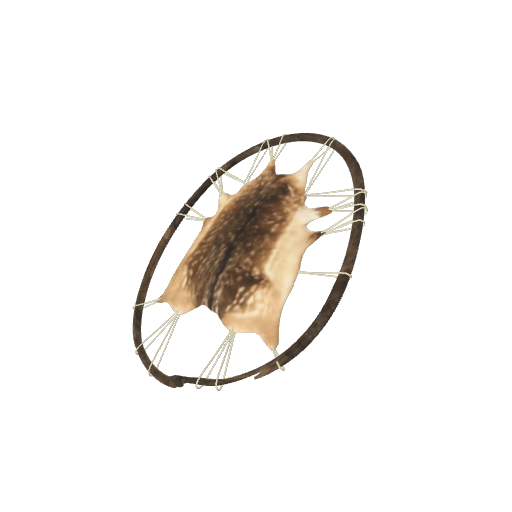Tanning rack
In the tanning process from animal skin to leather, a tanning rack is used to stretch the hide as it dries. The rack consists of a wooden frame pierced with small holes in which strings are threaded and attached to the skin. They are twisted several times around the frame to create uniform tension. The size of the frame varies according to the size of the hide. The hides, with or without fur, are used to make a variety of utilitarian or sacred objects, such as garments and blankets.
After the hunt, the animal skin is removed with a knife. Fleshing—or scraping—is the first step in leatherworking and involves removing residues with the potential to rot, such as flesh and fat. The hide is spread out on a fleshing beam and scraped from top to bottom with a tool called a fleshing knife. This repetitive step takes about a day and helps to even out the skin. At this stage, the fur is removed unless it needs to be preserved.
The hide is then stretched on the tanning rack for about two days. This period may be longer if the hide is too thick and needs to be fleshed again. If the process is interrupted, the resulting product is sinew (or babiche), which can be used as rope. If the process is uninterrupted, a fatty substance is applied to the dry hide to make it supple and rot-proof. The resulting leather is then washed and beaten to break up the fibres and add suppleness. Finally, the leather is placed next to the fire, where the smoke darkens its colour and makes it waterproof. The heat increases the fat’s rot-proof properties, while adding softening to the hide. The leather is then ready to be transformed into utilitarian or sacred objects.
References
Origin: Digital 3D drawing
Sources:
Gouvernement du Québec. (n.d.). Traitement de la peau d’orignal [Moose skin processing]. Répertoire du patrimoine culturel du Québec. Retrieved September 10, 2022, from https://www.patrimoine-culturel.gouv.qc.ca/rpcq/detail.do?methode=consulter&id=15&type=imma
